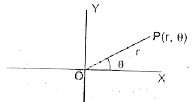A line OA of length r starts from its initial position OX and traces an angle AOB = α in the anitclockwise direction. It then traces back in the clockwise direction an angle BOC = 3θ ( where α>3θ). L is the foot of the perpendicular from C on OA. Also, sin3θCL=cos3θOL=1
2r2−1r is equal to
sinα
cosα
sinθ
cosθ
The correct Answer is:B
OL=rcos(α−3θ)
CL=rsin(α−3θ)

So, sin3θrsin(α−3θ)=cos3θrcos(α−3θ)=1
⇒sin3θsin(α−3θ)=cos3θcos(α−3θ)=r
Now cos4θ−sin4θ
=cosθ(rcos(α−3θ))−sinθ(rsin(α−3θ))
⇒cos2θ=rcos(α−2θ)
⇒cos2θ=r(cosαcos2θ+sinαsin2θ)
⇒(1−rcosα)cos2θ=rsinαsin2θ
⇒(1−rcosα)cos2θ=rsinαsin2θ ...(1)
cos3θsinθ+sin3θcosθ
=r[cos(α−3θ)sinθ+sin(α−3θ)cosθ]
⇒sinθcosθ=rsin(α−2θ)
⇒sin2θ=2r[sinαcos2θ−cosαsin2θ]
⇒(1+2rcosα)sin2θ=2rsinαcos2θ
⇒1+2rcosα2rsinα=cot2θ ...(2)
From (1) and (2), we get
1−rcosαrsinα=2rsinα1+2rcosα
⇒1−rcosα+2rcosα−2r2cos2α=2r2sin2α
⇒2r2−1r=cosα
Topper's Solved these Questions
- TRIGONOMETRIC RATIOS AND TRANSFORMATION FORMULASBOOK - CENGAGE PUBLICATIONCHAPTER - TRIGONOMETRIC RATIOS AND TRANSFORMATION FORMULASEXERCISE - Exercise (Matrix Match Type )
9 Videos
- TRIGONOMETRIC RATIOS AND TRANSFORMATION FORMULASBOOK - CENGAGE PUBLICATIONCHAPTER - TRIGONOMETRIC RATIOS AND TRANSFORMATION FORMULASEXERCISE - Exercise (Numerical Value Type )
38 Videos
- TRIGONOMETRIC RATIOS AND TRANSFORMATION FORMULASBOOK - CENGAGE PUBLICATIONCHAPTER - TRIGONOMETRIC RATIOS AND TRANSFORMATION FORMULASEXERCISE - Exercise (Multiple Correct Answer Type)
22 Videos
- TRIGONOMETRIC FUNCTIONS BOOK - CENGAGE PUBLICATIONCHAPTER - TRIGONOMETRIC FUNCTIONS EXERCISE - SINGLE CORRECT ANSWER TYPE
38 Videos
- TRIGONOMETRIC RATIOS FOR COMPOUND, MULTIPLE, SUB-MULTIPLE ANGLES, AND TRANSFORMATION FORMULAS BOOK - CENGAGE PUBLICATIONCHAPTER - TRIGONOMETRIC RATIOS FOR COMPOUND, MULTIPLE, SUB-MULTIPLE ANGLES, AND TRANSFORMATION FORMULAS EXERCISE - Multiple Correct Answers Type
6 Videos
Similar Questions
A line OA of length r starts from its initial position OX and traces an angle AOB = α in the anitclockwise direction. It then traces back in the clockwise direction an angle BOC = 3θ ( where α>3θ). L is the foot of the perpendicular from C on OA. Also, sin3θCL=cos3θOL=1
2rsinα1+2rcosα is equal to
View SolutionThe line passing through (−1,π2) and perpendicular to √3sin(θ)+2cos(θ)=4r is
View Solution
Knowledge Check
A line OA of length r starts from its initial position OX and traces an angle AOB = α in the anitclockwise direction. It then traces back in the clockwise direction an angle BOC = 3θ ( where α>3θ). L is the foot of the perpendicular from C on OA. Also, sin3θCL=cos3θOL=1
2rsinα1+2rcosα is equal toAtan2θBcot2θCcot2θDtan2θA line OA of length r starts from its initial position OX and traces an angle AOB = α in the anitclockwise direction. It then traces back in the clockwise direction an angle BOC = 3θ ( where α>3θ). L is the foot of the perpendicular from C on OA. Also, sin3θCL=cos3θOL=1
1−rcosαrsinα is equal toAtan2θBcot2θCsin2θDsin2θLet OP=rand∠XOP=θ then the position of P in polar coordinate system is represented by (r,θ) OX and O are called the initial line and pole respectively.
If p be the length of perpendicular from origin to line and if α is the angle which the perpendicular to the line makes with the initial line . The equation of line is given by r cos(θ−α)=p

The polar coordinates of the foot of perpendicular from the pole on the line joining the two points (r1,θ1)and(r2,θ2) areA⎡⎢ ⎢⎣r1r2sin(θ2−θ1)√r21+r22−2r1r2cos(θ1−θ2),tan−1(r1cosθ1−r2cosθ2r2sinθ2−r1sinθ2)⎤⎥ ⎥⎦B⎡⎢ ⎢⎣r1r2sin(θ2+θ1)√r21+r22−2r1r2cos(θ1−θ2),tan−1(r1cosθ1−r2cosθ2r2sinθ2−r1sinθ1)⎤⎥ ⎥⎦C⎡⎢ ⎢⎣−r1r2sin(θ2−θ1)√r21+r22−2r1r2cos(θ1−θ2),tan−1(r1cosθ1−r2cosθ2r2sinθ2−r1sinθ1)⎤⎥ ⎥⎦Dnone of these
The line passing through (−1,π2) and perpendicular to √3sin(θ)+2cos(θ)=4r is
View SolutionIf sin2θ=cos3θ and θ is an acute angle , then sinθ is equal to
View SolutionIf sin2θ=cos3θ and θ is an acute angle, then sinθ equals
View SolutionIf sinθ+sin2θ+sin3θ=sinα and cosθ+cos2θ+cos3θ=cosα , then θ is equal to
View Solutionsinθ+sin2θ+sin3θ=sinα and cosθ+cos2θ+cos3θ=cosα then θ is equal to
View Solution
